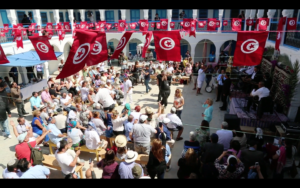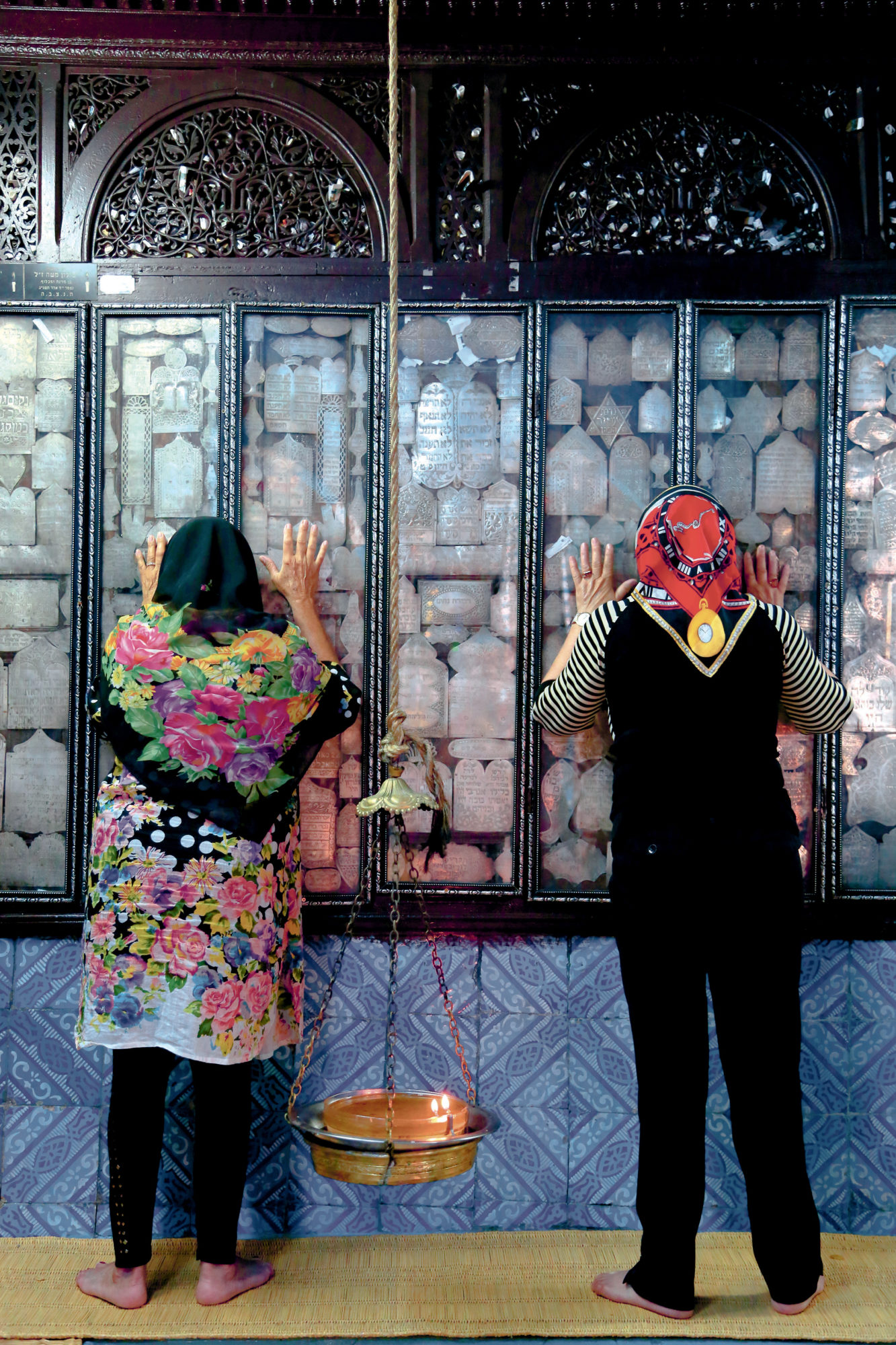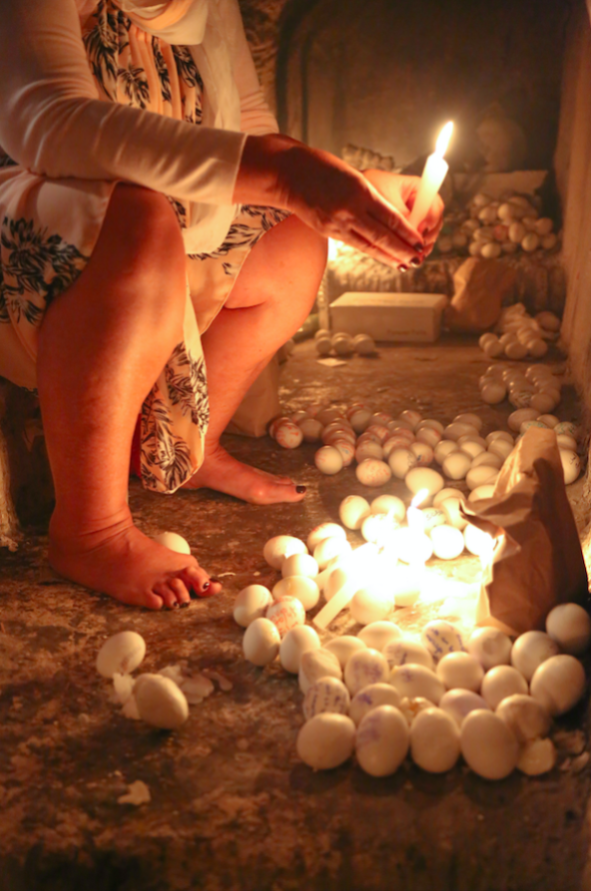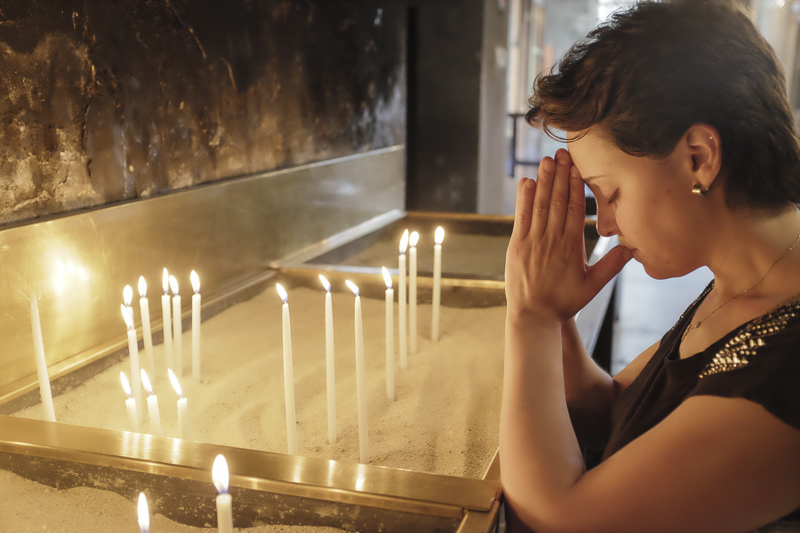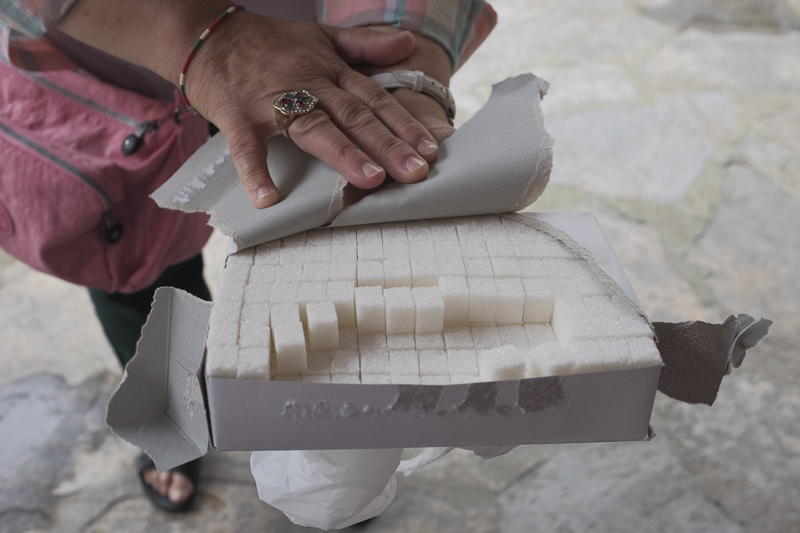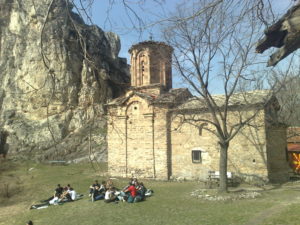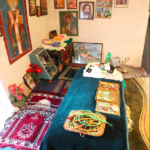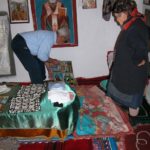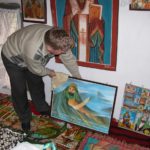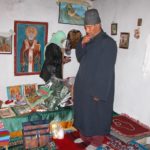This article investigates one particular narrative of “othering and belonging,” one that brings together the historical and contemporary experience of particular communities of Jews, Christians, and Muslims who have found it possible to work out various forms of coexistence.
As we grapple with contemporary American politics, it is clear that significant damage has been done to the core values that bind us, to our civil religion that appeals to unity, and to our common sense of purpose in our diversity. Such diversity and unity have been eviscerated by the body politic, by the innumerable ways in which our discourse of civility and inclusion has been shattered by this presidency and its divisive rhetoric. The language of the recent political discourse—that of othering, segregation, and exclusion—has brought even more real and symbolic violence to the range of possibilities Americans imagine. Even though none of these tropes of othering are entirely new in the United States where forms of group-based conflict, especially racism, are deeply rooted, they have recently acquired amplified prominence. It is clear that there is no time to waste and that we need to counter this damage with unremitting repair work at all levels—local, national, and global.
How do we provide alternative narratives and engage in debates that present the public with examples of belonging, inclusion, and sharing peacefully? As the media and internet become tools of manipulation, fake news, and easily captured sites of racial and religious hatreds, it behooves us to harness these tools for the goal of belonging.
Othering and belonging are both relational concepts that reflect on the nature of individual and group-based interactions. In one example of these concepts, john powell and Stephen Menendian define othering as “a set of dynamics, processes, and structures that engender marginality and persistent inequality across any of the full range of human differences based on group identities.”1)john a. powell and Stephen Menendian, “The Problem of Othering: Towards Inclusiveness and Belonging,” Othering & Belonging Expanding the Circle of Human Concern, Issue 1. By contrast, belonging can be defined as the same set of dynamics, processes, and structures that make it possible for comprehensive membership in the community of citizens. This is an important way of conceptualizing these notions since they allow for a more post nation-state contemporary perspective on identity, belonging, and citizenship. Consequently, many distinguish belonging from the concept of toleration which entails a partial belonging, based on the willingness of the powerful in society to grant acceptance. Belonging is by far more capacious since it demands full inclusion and membership in economic, social, and political structures of society. Furthermore, a society where there is group-based belonging has a political culture of inclusion, accommodation, and forbearance that values difference and understands that diversity enriches rather than threatens society. As powell and Menendian argue, “we must not only create inclusive structures, but we must foster new identities and inclusive narratives that can support us all.”2)Ibid. It is in this spirit that this article considers such concepts.
Most of the othering that happens in contemporary society is based on notions of identity, loosely defined as a mode of self-identification as well as an indicator of how individuals and groups are perceived by others. Such notions of identity based on class, race, religion, gender, and ethnicity are not only quite fluid and diverse, but they are also temporally constructed. As such, different historical periods have given rise to different identitarian struggles and some identities have remained important to group construction through times. Also, different people choose to emphasize distinct aspects of their identity, changing their focus in response to their relation with outside structures and peoples. So, a gender identity might predominate at certain moments, but a class identity at other times. We therefore need to pay attention to which identities are evoked for what purpose and in what context in order to understand the specifics of othering and belonging at particular sites. And we should reflect on how identities can work at local, national, and global registers at once.
In this article, I aim to discuss the particular phenomenon of sharing sacred sites in the Mediterranean—in history and as it continues in the contemporary world. The purpose of this discussion is not only to show how identities function in a particular case, but also to reflect on the narratives of belonging that such sites engender. These narratives, I argue, are certainly different and more local than full forms of belonging and inclusion into the polity. Yet, they serve various purposes. They have explanatory power since locals use them to explain their participation in sharing, but also, they spread within neighborhood networks that span beyond the mere restricted spaces around the sacred. Moreover, in a policy attempt, they can be circulated and used as examples of coexistence and accommodation that show that members of different groups with defined religious identities can adopt respectful coexistence.
Shared sacred sites are “holy” for members of multiple religious groups (which may as well be ethnically or nationally distinct) and serve not only as places where persons are brought together to respect the site in various ways, but also as sites where they are forced, by their coexistence, to mediate and negotiate their otherness. Such spaces of coexistence have been customary between Jews, Christians, and Muslims in the Mediterranean and the Middle East. Chronicles of the three Abrahamic religions are full of examples of cohabitation, hospitality, and tolerance despite a world torn apart by cultural, ethnic, and spiritual struggles. Sharing has biblical significance. “In a crucial episode related both in the Bible and the Qur’an, Abraham is said to have hosted with open arms three mysterious visitors, inviting them for a meal under the oak of Mamre where he lived. Often considered angels, one of these strangers sent by God promised him that his wife, Sarah, would have a child, Isaac, despite her great age.”3)Dionigi Albera, Karen Barkey and Manoël Pénicaud, “Introduction: Sharing Holy Places across the Mediterranean World,” Shared Sacred Sites. The act of accepting the visitors indicates the acceptance of the “foreigner” as a central theme of Abrahamic faiths.
Maps of the Mediterranean and Near East are strewn with shrines that have long been the sites of convergence for prayers, wishes, and contemplation, yet their origins of sharing differ.4)We have mapped some of these places in their historical representation in our Visual Hasluck project. Please see the maps in the Visual Hasluck segment of sharedsacredsites.net. Often local populations perceive a benefit in another group’s sacred space, or places become recognized because of their open-minded leaders who preach unity or by members of different religious groups who share said space for pragmatic reasons. Such sacred spaces are often outside the realm of the more traditional houses of worship which are mono-religious and adhere more strictly to the institutional culture, the rules and regulations of separation, maintenance, and purity. There are also exceptions, however, as I will describe later.
These sites that are shared are broadly construed as places of religious veneration, where communication with supernatural entities is frequent and where holy figures inhabit the space to render it sacred. In these spaces, individual religious leaders and practitioners are both significant, charismatic, and open to the flexibility of the space, welcoming joint prayer and ritual. Such sites are also freer in their practices since they are less controlled by religious institutions that impose their strict systems on the believers. It is such sites that are more frequently shared by multiple religions. Often these places are shrines that function as tekkes (Sufi lodges) or türbes (Sufi burial places, mausoleums) or Orthodox Christian churches. An important segment of the historical material on shared sites in the Middle East can be explored throughout the history of the Seljuk and Ottoman empires, both established at the frontiers of Christianity and having conquered territories that belonged to Byzantines.
Coexistence in the Ottoman Empire
Historically, the coexistence between groups and the sharing of religious sacred sites has occurred under the aegis of imperial states that were interested both in maintaining and in manipulating diversity. They have also emerged as a result of the vast population movements in the Mediterranean, bringing peoples of different beliefs closer together. Historical conditions where states were formed within syncretic environments and as hybrid entities helped shape tolerant attitudes toward diversity. Thus, one general hypothesis would be that the more open a state is to ethnic or religious difference, the more likely it is for coexistence to be cultivated and the sharing of sacred sites to be allowed and accepted. In fact, many pre-modern empires that were stretched thin across vast territories understood quite well that they would not be able to homogenize their populations and since maintaining their control over these populations was far more important, they reframed diversity as a positive value, just enough so that relations between religious and ethnic groups remained peaceful.5)Karen Barkey, Empire of Difference: Ottomans in Comparative Perspective (Cambridge: Cambridge University Press, 2008).
During the early days of the Ottoman Empire, coexistence was driven by the example of local cases of cooperation across the frontiers between Byzantines and Seljuks. The first sultans of the Ottoman Empire, following their conquests in the Balkans, were also interested in showing deference and tolerance towards the settled Christian populations as they knew the Ottomans were demographically vulnerable. Colonization strategies were sometimes based on this cooperation in that they attempted incorporation of local communities rather than unyielding domination. Their usable past, their history also points towards the multiethnic steppes of Central Asia where they comingled with multiple groups. As a result, sultans and their colonizer companions, often Sufi sheiks were quite open to Christianity and eager to maintain good relations. Therefore, the Ottoman Empire’s colonization practices allowed for inclusion early on, and these values permeated throughout their early rule. Even as they settled into their empire, developing a much stronger Islamic identity, sultans created a tolerant environment under which Christian and Jewish communities could exist. The empire found success in incorporation partially because religious leaders who were responsible for spreading the Islamic message did so in a manner that tempered Islam and created an approachable Islamo-Christian framework under which the local communities could function.6)Elazar Barkan and Karen Barkey, Choreographies of Shared Sacred Sites: Religion, Politics, and Conflict Resolution, (New York: Columbia University Press, 2015).
The Ottoman Empire favored coexistence between different ethno-religious communities, even as it organized them into separate and autonomous units, called millets. Strategies of territorial and socio-religious contiguity, the movement of Ottoman settlers right next to Christian hamlets, the establishment of Sufi convents with soup kitchens and lodges open to all irrespective of religion, the maintenance of churches and the allowing of Christian worship to continue in spaces converted to mosques, the mixed faith marriages sultans preferred (especially with Christian women) presented opportunities for Christian-Muslim coexistence.7)Karen Barkey, “Religious Pluralism, Shared Sacred Sites, and the Ottoman Empire” in Choreographies of Shared Sacred Sites.
Though the Ottoman authorities converted many churches into mosques, Christians were often offered space to pray within these converted spaces. There was no legal sanction for this practice, but in some communities, it became the norm for Muslims to look the other way as Christians continued using the mosques to pray. When churches were not converted, often Muslims attracted by perceived benefits of the space or the holy figure represented by the church, moved in to pray jointly with the Christians. These relations across sites were nurtured by the presence of religious stories and holy figures which eased the cultural back and forth between communities, furthering increased knowledge and familiarity, each breeding their own form of co-presence and sometimes a form of benevolent coexistence.8)Ibid. In converting Christian churches into Muslim spaces or in the reciprocal attendance of each other’s shrines, religious traditions and figures often were made to converge. When the distinctiveness of the Christian religion still infused converted sites, Christian symbols remained but were often reimagined to suit Islam. For example, in many sites saintly figures such as Saint George or Saint Theodore were associated with the Muslim saintly figure Khidr. A prophet or a “saint” of Islam, Khidr who traveled across space and time provided the perfect narratives to facilitate joint worship. In the Middle East, the association between the Muslim prophet Khidr, the Orthodox Christian Saint George, and the Jewish Prophet Elijah, has always connected Islam to Christianity and Judaism and enabled the invention of shared stories and shared spaces.9)“Visual Hasluck: Mapping Christianity and Islam in the Mediterranean,” http://vh.dimaterialist.net/. This shows us that despite theological differences, the Abrahamic religions possess many common elements, such as beliefs, rites, stories, and personages. Messages of reception together with the commonalities of beliefs, prophets, and rituals lubricate the exchanges across otherness. These mutual influences and superimpositions form a fertile ground for the sharing of sacred sites, but sometimes they may also generate partition between different denominations.10)There certainly are numerous examples of sacred sites which are not shared, separated and where partitions are the only ways to maintain peace. In this article I chose to reflect on those cases that remain examples of sharing.
The imperial model then, at least in the case of the Ottoman Empire, respected difference, accommodated and included diversity within a framework of belonging that was not modern or democratic, but allowed for forms of imperial participation. In the contemporary world, these sites operate within different political and cultural contexts.
Shared Sites in the Mediterranean:
Contemporary Examples
Historical cases flourished under empires, and in many places they continued even though the nation-states which were formed out of the ruins of empire were adamant about creating homogeneity and uniformity. Such uniformity would usually preclude inter-faith commitments and coexistence. Furthermore, since the rise of Islamic politics in the Middle East, Islam has become a prominent force actively resisting attempts at mixing or syncretism of any sort. Despite such forces, still today the maps of the Mediterranean and the Near East are sprinkled with examples of shared sacred sites. Yesterday as today, many believers—Jews, Christians, and Muslims—pray in the holy place of another religion. This is even more significant since our contemporary world is torn apart by ethnic, political, and religious struggles and many nations-states are under the sway of religious nationalism. Therefore, there could be no better illustration of coexistence than the extensive history of sacred sites shared by members of different beliefs and backgrounds. The following examples are important in that they reflect the possibilities of coexistence—the power and success of engaging the “other” in spaces of worship. Even though they often operate in national contexts that are fraught, these spaces represent the better dispositions of peoples who negotiate across their differences and as such, they remain important to disseminate, to use as positive examples of accommodation and acceptance.
The observation of such cases of mixed worship in many shrines demands that we think through the original notions of othering and belonging that we started with. The notion of hospitality which is observed in many shared sacred sites is not the same as belonging in the way defined by powell and Menendian. Belonging in these cases is a temporally defined phenomenon, even though it is based on long held traditions and structures of “living together” and respect for the other. In many of these places, ownership is in the hands of one religious denomination that controls the space, and the members of different religions who choose to worship there come at specific times during the week for specific moments of ritual or pilgrimage. As temporary visitors, they do not claim ownership of the site. Instead they solicit a form of temporary participation in the space and its rituals that reflects respect and inclusion in the larger tradition of the place. For one thing, these churches, synagogues, or shrines are well known to be open to other religions and to bring some benefit regardless of religious affiliation. Often people of different faiths converge in the same sanctuary because they are animated by a common quest for supernatural help and seek the protection of a particular saint with a reputation for efficacy. Therefore, they perceive their participation as temporary, and even though they share in the bounty of their hosts’ hospitality, they do so with reserve.
Such belonging is also understood today as the legacy of a long-standing “cosmopolitanism” of empire. The compilation of such modes of coexistence represents the traditions of the Ottoman lands, the semiconscious solutions, and instincts that made people navigate their daily lives by participating in multiple religious and cultural institutions at once, facilitated by the fluidity of boundaries and the multi-vocality of messages. Believers explicitly bring back memories of these past practices as carried out by their ancestors in order to partake in a sense of nostalgia. In each case, a particular past with a multi-ethnic and multi-religious context is brought to bear on the explanations for continued sharing and coexistence. By bringing up the past, belonging is justified as continuity, tradition; and the effect of such claim-making is often a rapprochement between people of different religions.
The benefits of such participation in the sacred spaces and rituals of the other are not about a strong sense of belonging and comprehensive membership in the nation-state. It is more about spreading the message of community, similarity of experience, and the expansion of ties at local levels. Members of different faiths who encounter each other in shared shrines not only seem to relate to each other in further occasions, but also create weak ties that extend further then strong ties and bind different communities together. Ultimately, the belonging and othering in these cases has to also be considered in the larger national context where these local examples remain significant, yet not widespread. Furthermore, especially in the case of rising Islamic politics, the visitation of Muslims to Christian or Jewish sites has not appeased the larger politics of Sunni dominance as is strongly the case in Turkey. Therefore, while a form of belonging is experienced at the level of the shrine, many ways of othering continue as Islam becomes more dominant in society. As such, we have to distinguish between the local levels of sociability and the national level of politics. In the following section, I give three examples of belonging, each temporary, yet each reflecting strong inter-faith relations, some diasporic, others more local and continuous. Each of the cases below is set in an increasingly homogeneous nation-state where sameness is preferred to difference. Yet, these spaces continue to exist.
THE GHRIBA SYNAGOGUE IN DJERBA, TUNISIA
Documentary on the Ghriba Synagogue by Manoël Pénicaud
The Ghriba Synagogue in Djerba, Tunisia is located in Harah Sghria village on the island of Djerba and is shared by Jews and Muslims both during a particular pilgrimage as well as more commonly at other times during the year. The village was formerly home to a predominantly Jewish population. There have been varying accounts of the founding of this synagogue. One such story reveals that after the First Temple of Jerusalem was destroyed, priests settled on Djerba, bringing with them a stone and door from Solomon’s temple. Djerba acted as a refuge for these Jews, and the Ghriba Synagogue served as a link between the destruction of the Second Temple and the formation of a Jewish diaspora.
Another account informs that the synagogue was built on the site of a cabin where tradition says that a young woman died in a fire. Though her house was burnt, her body remained intact. According to legend, the young woman had never been accepted by the community, and it was only after her miraculous death that the people understood her sanctity. The name of the synagogue is a reference to this mysterious woman as the Jewish saint El Ghriba means “the Stranger” or “the Miraculous.”11)Haim F. Ghiuzeli, “El Ghriba Synagogue, Djerba, Tunisia,” Beit Hatfutsot, accessed March 11, 2018, https://www.bh.org.il/el-ghriba-synagogue-djerba-tunisia/. Present day visitors insist that since the religious identity of this young woman was never really determined, both Jews and Muslims worship at Ghriba. This is interesting since it shows how a particular narrative is fashioned and repeated through generations to justify the joint veneration of the space. Worshippers will also say that though this space is a synagogue, all worshippers enter the space in the same way one enters a mosque, by removing their shoes and covering their head. Yet, it is also true that Jews entered the Temple barefoot.12)Manoël Pénicaud, “The Ghriba synagogue in Djerba: A shared holy place for Jews and Muslims,” Shared Sacred Sites: A Pilgrimage in New York, Catalogue, 2018. The rituals in the synagogue have been described by Manoël Pénicaud as bringing Jews and Muslims together in their wish making, barely distinguishing between them.13)Ibid.
In the late twentieth century, Jews began emigrating from Djerba. However, a month after the end of Passover Jews make the pilgrimage to Djerba in celebration of Lag BaOmer, the Jewish festival. The pilgrimage and the Ghriba Synagogue are symbols of the centuries of Muslim-Jewish coexistence in North Africa. Tunisian Jews as well as Jews from Europe and Israel come to the Ghriba Synagogue annually. Outside of the synagogue venders sell Jewish-Tunisian wares and kosher Tunisian food, symbolic of accommodation that occurs in this space. Jews and Muslims are present during the festival and are proud to declare their joint worship.
- Manoël Pénicaud, Jewish and Muslim Women Praying toward Jerusalem
- Manoël Pénicaud, The Ghriba
Manoël Pénicaud, Jewish and Muslim Women Praying toward Jerusalem (left) & The Ghriba (right)
Jewish and Muslim faiths have long coexisted and crossed over in North Africa. Shared spaces like the one in Djerba were common as both religions prayed at one another’s shrines. Visiting the tombs of saints was also a shared practice, facilitated even more by saints and their stories common to both religions. Even though the migration of Jews from this region led to the decline of religious crossover, continued visits by Jews for the annual pilgrimage make Djerba and the Ghriba Synagogue an exception. In 2002, a truck bomb went off near the Ghriba Synagogue, temporarily debilitating the Jewish presence in the region during the annual pilgrimage. The synagogue has recovered from this downturn in attendance, and today a number of Jewish pilgrims make the trip to Djerba and contribute to the model of Muslim-Jewish coexistence. Such continuity forces us to consider the power of coexistence and joint worship which resists attempts of destruction.
THE CHURCH OF THE MOTHER OF GOD AT VEFA, ISTANBUL, TURKEY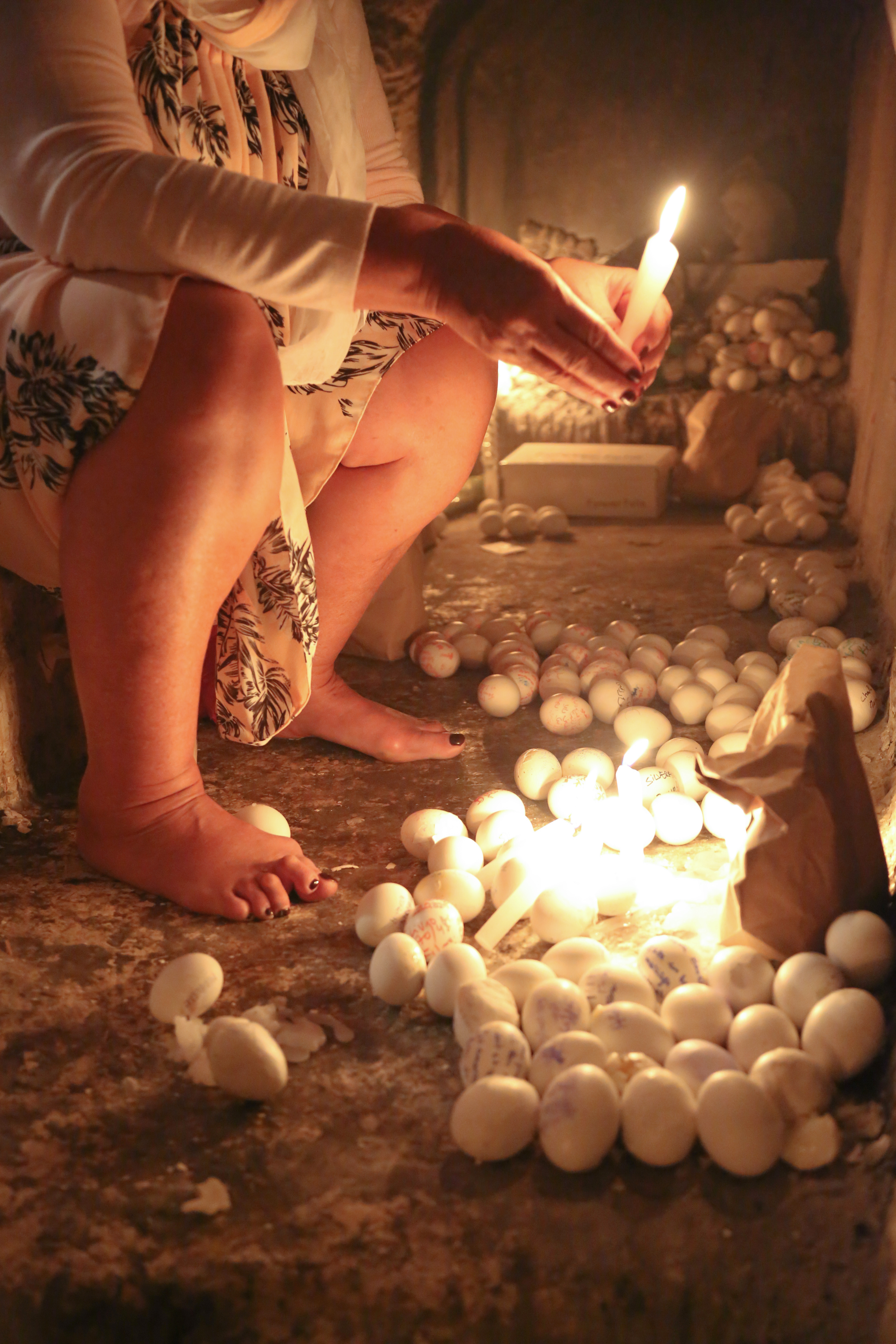
The Church of the Mother of God, also known as Vefa, in Istanbul, Turkey has a long history of sharing as Christian, Muslim, and Jewish communities have long populated the church, known for the healing powers of its aghiasma (holy water). The church is most active on the first of every month for the monthly pilgrimage, but Tuesday and Thursday mornings until noon are also popular visiting times, when people come to pray, light a candle, make a wish, collect some holy water, and get blessed by the priest before going about the rest of their daily routine. The Church of Vefa reflects the coexistence between Christians, Jews, and Muslims in Istanbul, the shared history they remember from their Ottoman past, and their willingness to claim continued cosmopolitan belonging despite the extreme narrowing of pluralistic space in the new Turkey.
Documentary on the Church of the Mother of God by Vefa Kilisesi, Noah Arjomand, and Karen Barkey
On pilgrimage days, the crowds at the Church of the Mother of God can reach into the thousands, as regular congregants are joined by people from all walks of life who want to participate in the observance, go through the rituals, make their wish, and then linger to speak to others about their experience. On these days, the church is open from early morning until six in the evening, and one’s presence at the church is bookmarked by festive, friendly mixing at the large courtyard. It is in the courtyard where most of the conversations, cheerful and plaintive, take place, and where friendships are renewed with opportunities for sharing the pleasures and the burdens of life. Especially after the prayers, people—young or old, male or female, religious or secular, wearing a headscarf or donning a short skirt, rich or poor, alone or among friends, as a family or as an individual, architects, lawyers, artists, businessmen, and artisans of all kinds—find themselves lingering in the courtyard. Crowds mingle and chat, offering candy and chocolate when their wishes have come true. It is here in the courtyard that religions also mix. Women offering candy explain that the practice of handing out sweets after an auspicious event is Muslim, but, they hasten to add that this custom fits well with the local tradition of wish-making and sprinkling of holy water. Traditions, rituals, and practices are discussed as not the same, but compatible. Each time, narratives are told of shared rituals, prophetic figures and shared desires.
Everyone knows the rituals of this little Greek Orthodox church. As people first enter, they stop and buy a few metal keys, each symbolizing a wish to be made. They then continue on to buy a few candles—a symbol of the light of Christ—which are then lit and placed into a stand. As men and women stream in front of the lit candles, they take a moment to pause, hold their hands in imploration, and pray. Christian men and women hold their hands folded, and Muslims have their hands raised and palms open, praying next to each other, different just in their particular ritual gesture of imploration. Worshippers then often pass their keys in ritualized behavior over the small window boxes on the walls that contain old icons, following the edges of the boxes, circling a few times—some say three times exactly, others seven, depending on their religious and mystical beliefs. When the circuit on the ground level of the church is finished, visitors move downstairs, where a fountain, more icons, and a small statue of Jesus are located. Believers wash their hands and face with the holy water of the aghiasma, take small bottles of the water for home, and pray and often cross themselves in front of the statue of Jesus, before moving back upstairs to join the long line of people waiting to be blessed by the priest. A lot of this ritual is performed by individuals, going through the numerous behaviors on their own, praying to God, but also furtively watching others to get the sacraments right.
While waiting in line, people mingle, share stories, gossip, and tell each other the history of their involvement in the church. Even though some of the gestures and acts of worship are not strictly a part of the rituals, the mixing of traditions clearly surfaces in the details of the acts of devotion; the hand gestures, the washing of hands seven times, the distribution of candy—these things all attest to the ways in which Christian and Muslim traditions have mixed in this sacred shared site.14)Karen Barkey, “The Church of the Mother of God at Vefa, Istanbul,” Summer 2013, http://sharedsacredsites.net/fieldwork/our-fieldwork/fieldwork-in-greece-and-turkey-2013-16/vefa/ Beyond the rituals of sharing, especially secular Muslims and Jews who patronize this church make numerous references to the politics of the times, to the dominance of a religious party and the consequences of a strong Islamic discourse. For them, the local practices are a form of refutation of the national narratives of “Sunnification.”
- Noah Arjomand, The Church of the Mother of God
- Noah Arjomand, The Church of the Mother of God
- Noah Arjomand, The Church of the Mother of God
Noah Arjomand, The Church of the Mother of God
CRKVA SVETI NIKOLA/H’DIR BABA TEKKE IN MAKEDONSKI BROD, MACEDONIA
- Manoël Pénicaud, Sveti Nikola Tomb and Iconography
- Glenn Bowman, Sveti Nikola, Tomb and Iconography
- Glenn Bowman, Sveti Nikola, Tomb and Iconography
- Glenn Bowman, Sveti Nikola tomb and iconography with Sufi dervish praying
Manoël Pénicaud, Sveti Nikola Tomb and Iconography (first)
Glenn Bowman, Sveti Nikola, Tomb and Iconography with Sufi dervish praying (second, third, and fourth)
Sveti Nikola/Hadir Baba Tekke is used by Orthodox Christians and Muslims as a singular worship space in the Macedonian town of Makedonski Brod.15)Makedonski Brod is a small town in the central part of the Republic of Macedonia which became independent in 1991. Part of the reason these communities share the space is the Christian belief that in the pre-Ottoman period, the location was the Church of Saint Nicholas. The conquering Ottomans converted the space to a tekke, a Sufi monastery. Muslims believe the tekke was founded by the Bektashi saint Hadir Baba. Christians in the town tell a story of Saint Nicholas saving townspeople from the plague. Saint Nicholas is said to be buried under the church. The same story is told by Muslims about Hadir Baba. Hence the joint name, Sveti Nikola for Christians and Hadir Baba Tekke for Muslims. The space served as a Muslim shrine until World War I, after which it fell into disrepair. It was converted to a church in the 1980s or 1990s.
Since then, the shrine has become multi-religious as both Muslims, mostly dervishes from the Bektashi order as well as Sunnis, and Orthodox Christians worship within the church. The shared significance of the site has led to each group accommodating one another in their use of the site. The church’s architecture is one way that the space creates room for both faiths. The roof is made of ceramic tiles trimmed with wood, reminiscent of nineteenth century mosques. The interior of the church has a simple iconostasis and icons which, according to visitors, were painted recently. The floor covered with carpets and rugs reflects the Muslim türbe features. Carpets with Muslim designs and prayers are placed around the tomb and pictures of Ali and Hüsein. Pictures of Bektashi saints are also hung on the west and south walls. This space features an incredible mixture of Christian and Muslim iconography and imagery, meant to facilitate visits and engender hospitality for both religious groups.16)john a. powell and Stephen Menendian, “The Problem of Othering: Towards Inclusiveness and Belonging,” Othering & Belonging Expanding the Circle of Human Concern, Issue 1.
Accommodation is also displayed during major holidays and religious festivals. For Christians, the most significant day is May 6, Saint George’s day. In preparation for the celebration, the prayer rugs and depictions of Muslim saints are placed in storage. Christians celebrate on May 5 when they take branches and leaves from the church to decorate their doorways and on May 6 when there is a liturgy followed by wish-making and swinging in the courtyard. On May 7, the caretakers carefully but quickly replace the prayer rugs and depictions of Mecca, Ali, and Hussein around the tomb. Such hybrid representation as well as respect for the particularity of one tradition on certain days, reflects on the understanding that each group has of the common past of this shrine. As long as the locals maintain the shrine and open it to both religions such hospitality maintains a shared belonging that is valued by both sides. But, as Bowman also shows there are also indications of conflict, when outsiders come in to shift the precarious balance maintained by centuries of elaborate choreographies.
The communities that worship at Sveti Nikola/Hadir Baba Tekke represent peaceful cohabitation. Instead of allowing the two different historical narratives of the space’s founding to divide them, the groups appreciate the significance the space holds for each other. In so doing, they have found ways to create a way for both groups to worship together, where they value similarities and accept differences.17)Elizabeta Koneska, “Shared Shrines in Macedonia,” Winter 2013, accessed March 16, 2018, https://eefc.org/post-folklorista/shared-shrines-in-macedonia/18)Glenn Bowman, “Orthodox-Muslim Interactions at ‘Mixed Shrines’ in Macedonia,” pp. 195-219 in Chris Hann and Hermann Goltz, Eastern Christians in Anthropological Perspective (Berkeley: University of California Press, 2010).
Conclusion
This essay explored the concept of belonging in the context of shared sacred sites, religious sanctuaries in the former lands of the Ottoman Empire, which continue to be shared by members of different religions peacefully. I argued that the belonging in these spaces was of a particular type, not indicative of a fully inclusive national space of citizenship and equality. No doubt these spaces are easier to describe as a form of belonging since they are exceptional spaces in the larger national framework of ethnic and religious relations. None of the countries in which they are now located, Tunisia, Turkey, and Macedonia are free of ethnic and religious inequities of various sorts, yet, the continued existence of such spaces of respectful forbearance reflects the possibilities of human coexistence across boundaries.
References
| 1. | ↑ | john a. powell and Stephen Menendian, “The Problem of Othering: Towards Inclusiveness and Belonging,” Othering & Belonging Expanding the Circle of Human Concern, Issue 1. |
| 2, 8, 13. | ↑ | Ibid. |
| 3. | ↑ | Dionigi Albera, Karen Barkey and Manoël Pénicaud, “Introduction: Sharing Holy Places across the Mediterranean World,” Shared Sacred Sites. |
| 4. | ↑ | We have mapped some of these places in their historical representation in our Visual Hasluck project. Please see the maps in the Visual Hasluck segment of sharedsacredsites.net. |
| 5. | ↑ | Karen Barkey, Empire of Difference: Ottomans in Comparative Perspective (Cambridge: Cambridge University Press, 2008). |
| 6. | ↑ | Elazar Barkan and Karen Barkey, Choreographies of Shared Sacred Sites: Religion, Politics, and Conflict Resolution, (New York: Columbia University Press, 2015). |
| 7. | ↑ | Karen Barkey, “Religious Pluralism, Shared Sacred Sites, and the Ottoman Empire” in Choreographies of Shared Sacred Sites. |
| 9. | ↑ | “Visual Hasluck: Mapping Christianity and Islam in the Mediterranean,” http://vh.dimaterialist.net/. |
| 10. | ↑ | There certainly are numerous examples of sacred sites which are not shared, separated and where partitions are the only ways to maintain peace. In this article I chose to reflect on those cases that remain examples of sharing. |
| 11. | ↑ | Haim F. Ghiuzeli, “El Ghriba Synagogue, Djerba, Tunisia,” Beit Hatfutsot, accessed March 11, 2018, https://www.bh.org.il/el-ghriba-synagogue-djerba-tunisia/. |
| 12. | ↑ | Manoël Pénicaud, “The Ghriba synagogue in Djerba: A shared holy place for Jews and Muslims,” Shared Sacred Sites: A Pilgrimage in New York, Catalogue, 2018. |
| 14. | ↑ | Karen Barkey, “The Church of the Mother of God at Vefa, Istanbul,” Summer 2013, http://sharedsacredsites.net/fieldwork/our-fieldwork/fieldwork-in-greece-and-turkey-2013-16/vefa/ |
| 15. | ↑ | Makedonski Brod is a small town in the central part of the Republic of Macedonia which became independent in 1991. |
| 16. | ↑ | john a. powell and Stephen Menendian, “The Problem of Othering: Towards Inclusiveness and Belonging,” Othering & Belonging Expanding the Circle of Human Concern, Issue 1. |
| 17. | ↑ | Elizabeta Koneska, “Shared Shrines in Macedonia,” Winter 2013, accessed March 16, 2018, https://eefc.org/post-folklorista/shared-shrines-in-macedonia/ |
| 18. | ↑ | Glenn Bowman, “Orthodox-Muslim Interactions at ‘Mixed Shrines’ in Macedonia,” pp. 195-219 in Chris Hann and Hermann Goltz, Eastern Christians in Anthropological Perspective (Berkeley: University of California Press, 2010). |

